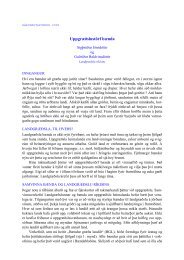Factors involved in ice nucleation and propagation ... - Landbunadur.is
Factors involved in ice nucleation and propagation ... - Landbunadur.is
Factors involved in ice nucleation and propagation ... - Landbunadur.is
You also want an ePaper? Increase the reach of your titles
YUMPU automatically turns print PDFs into web optimized ePapers that Google loves.
ICE NUCLEATION AND PROPAGATION IN PLANTS 43<br />
tions the reduction or <strong>in</strong>terference of extr<strong>in</strong>sic<br />
<strong>ice</strong> nuclei would provide significant frost protection.<br />
Recently the ability to use <strong>in</strong>frared video<br />
thermography (Figure 1) to directly observe<br />
<strong>ice</strong> <strong>nucleation</strong> (i.e., <strong>in</strong>itial <strong>ice</strong> formation) <strong>and</strong><br />
<strong>propagation</strong> <strong>in</strong> plants has been demonstrated<br />
(Carter et al., 1999; Ceccardi et al., 1995; Fuller<br />
<strong>and</strong> W<strong>is</strong>niewski, 1998; LeGr<strong>ice</strong> et al., 1993;<br />
W<strong>is</strong>niewski et al., 1997; W<strong>is</strong>niewski, 1988;<br />
W<strong>is</strong>niewski <strong>and</strong> Fuller, 1999; Workmaster et<br />
al., 1999). The use of th<strong>is</strong> technology to study<br />
the freez<strong>in</strong>g process <strong>is</strong> based on the fact that<br />
<strong>ice</strong> formation <strong>is</strong> an exothermic event <strong>and</strong> the<br />
release of the heat of fusion as water changes<br />
phase from a liquid to a solid can be monitored<br />
<strong>and</strong> v<strong>is</strong>ualized. The temperature <strong>and</strong> spatial<br />
resolution of the dev<strong>ice</strong> used <strong>in</strong> these studies<br />
has enabled the researchers to clearly def<strong>in</strong>e<br />
Figure 1. Use of <strong>in</strong>frared thermography to study<br />
freez<strong>in</strong>g <strong>in</strong> plants. Infrared camera (Inframetrics<br />
Model 760 Infrared Radiometer) <strong>is</strong> set up <strong>in</strong>side<br />
an environmental chamber along with a potted<br />
strawberry plant. Control unit sitt<strong>in</strong>g on top of a<br />
video monitor <strong>is</strong> used to adjust the camera parameters<br />
while the experiment <strong>is</strong> <strong>in</strong> progress. The<br />
entire experiment <strong>is</strong> videotaped for future evaluation.<br />
1. mynd. Notkun <strong>in</strong>nrauðrar hitaljósmyndunar til<br />
rannsókna á frostferli í plöntum. Innrauð ljósmyndavél<br />
(Inframetrics Model 760 Infrared Radiometer)<br />
er komið fyrir <strong>in</strong>ni í frystiklefanum, ásamt jarðarberjaplöntu<br />
í potti. Stýribúnaður ofan á myndb<strong>and</strong>sskjá<br />
er notaður til að stilla breytur myndavélar<strong>in</strong>nar<br />
á meðan á tilraun<strong>in</strong>ni stendur. Öll tilraun<strong>in</strong> er tek<strong>in</strong><br />
upp á myndb<strong>and</strong> og árangur met<strong>in</strong>n síðar.<br />
the <strong>in</strong>itial site of <strong>ice</strong> <strong>nucleation</strong> as well as<br />
monitor the <strong>ice</strong> front as it spread <strong>in</strong>to the surround<strong>in</strong>g<br />
t<strong>is</strong>sues. Us<strong>in</strong>g <strong>in</strong>frared thermography<br />
it <strong>is</strong> possible to determ<strong>in</strong>e the role of extr<strong>in</strong>sic<br />
<strong>and</strong> <strong>in</strong>tr<strong>in</strong>sic <strong>ice</strong> nucleat<strong>in</strong>g agents <strong>in</strong><br />
the freez<strong>in</strong>g process, rates of <strong>ice</strong> <strong>propagation</strong>,<br />
the effect of plant structure on the freez<strong>in</strong>g<br />
process, <strong>and</strong> how the specific pattern of freez<strong>in</strong>g<br />
relates to v<strong>is</strong>ual patterns of <strong>in</strong>jury. It <strong>is</strong> also<br />
possible to clearly evaluate if the reduction of<br />
<strong>ice</strong> nuclei or <strong>in</strong>hibit<strong>in</strong>g their activity <strong>is</strong> a feasible<br />
approach to frost protection. The present<br />
report will provide an overview of these various<br />
studies <strong>and</strong> detail the factors that apparently<br />
play a significant role <strong>in</strong> determ<strong>in</strong><strong>in</strong>g<br />
when a plant will freeze <strong>and</strong> how <strong>ice</strong> will<br />
propagate through a plant.<br />
ROLE OF MOISTURE AND EXTRINSIC<br />
ICE NUCLEATING AGENTS<br />
One of the critical factors <strong>in</strong> determ<strong>in</strong><strong>in</strong>g when<br />
a plant will freeze <strong>is</strong> the presence or absence<br />
of surface mo<strong>is</strong>ture. Dry plants will always<br />
supercool to a lower temperature than wet<br />
plants. Secondly, if <strong>ice</strong> nucleat<strong>in</strong>g agents, such<br />
as INA bacteria, are present, they will <strong>in</strong>duce<br />
plants to freeze at a warmer temperature than<br />
just the mo<strong>is</strong>ture alone (W<strong>is</strong>niewski et al.,<br />
1997; Fuller <strong>and</strong> W<strong>is</strong>niewski, 1998). The presence<br />
of nucleators on the surface without mo<strong>is</strong>ture<br />
<strong>is</strong> not effective because nucleators are<br />
only active <strong>in</strong> aqueous solutions.<br />
ROLE OF THE CUTICLE AND<br />
STOMATES IN EXTERNAL INDUCTION<br />
OF FREEZING<br />
In order for the presence of external <strong>ice</strong> (frozen<br />
mo<strong>is</strong>ture on a leaf surface) to <strong>in</strong>duce <strong>ice</strong><br />
formation <strong>in</strong> a plant, the <strong>ice</strong> must physically<br />
grow through a break <strong>in</strong> the surface of the<br />
cuticle (e.g. cracks or broken hair cells) or<br />
through a stomatal open<strong>in</strong>g (Figure 2). A thick<br />
cuticle, such as found on evergreen leaves<br />
(e.g. azalea, cranberry), serves as an effective<br />
barrier to external <strong>nucleation</strong> (W<strong>is</strong>niewski <strong>and</strong><br />
Fuller, 1999; Workmaster et al., 1999). Wa-
















